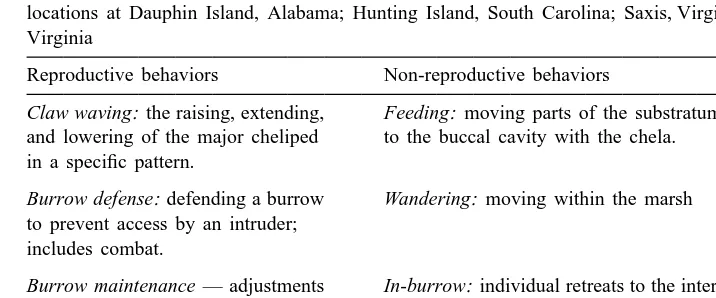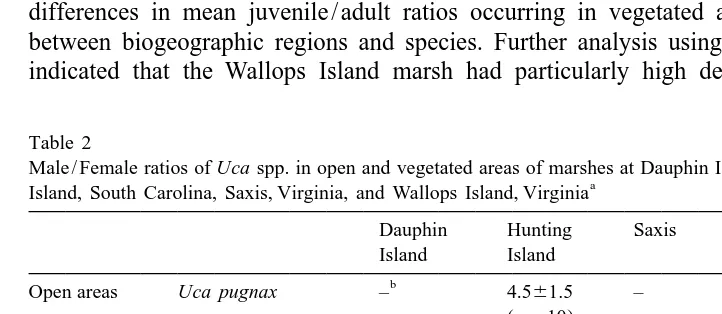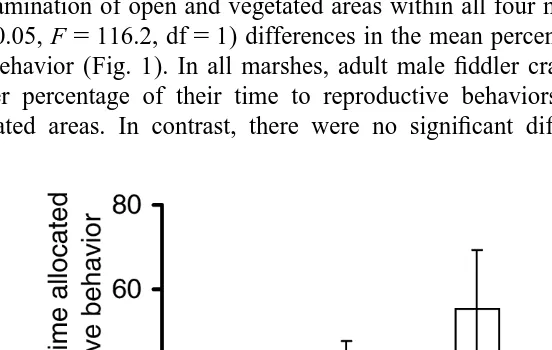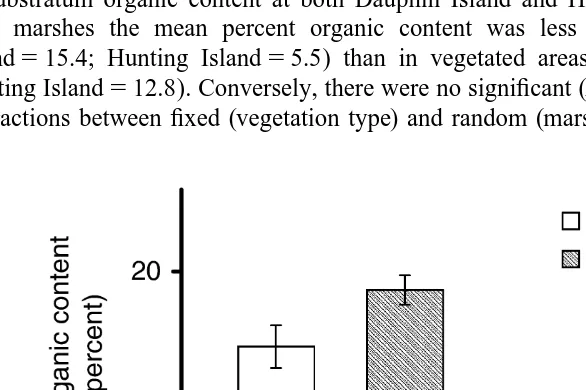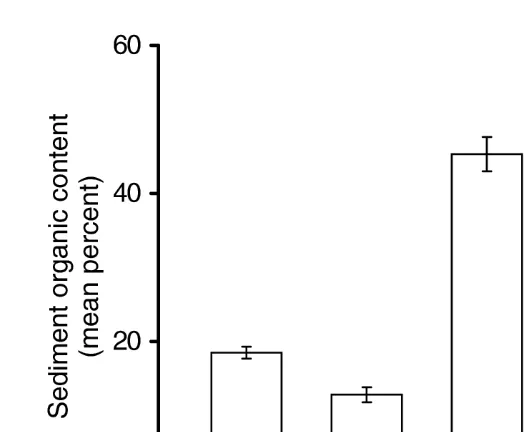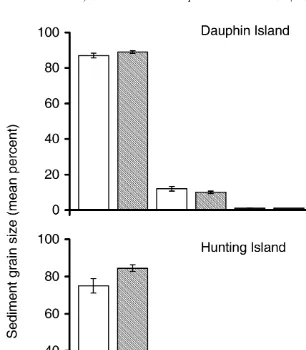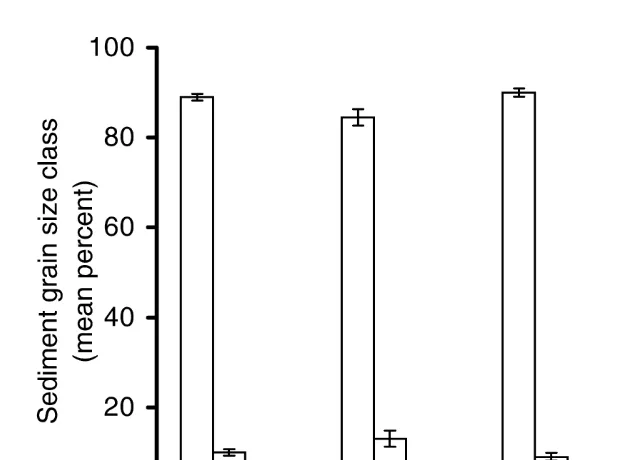254 (2000) 109–121
www.elsevier.nl / locate / jembe
An evaluation of lekking behavior in the fiddler crab
Uca spp.
*
George A. Croll , James B. McClintock
Department of Biology, University of Alabama at Birmingham, Birmingham, AL 35294-1170, USA
Received 11 January 2000; received in revised form 7 July 2000; accepted 1 August 2000
Abstract
The reproductive behavior of Uca spp. has been extensively studied, especially the relationships between the dimorphically enlarged male claw and reproductive success. In contrast, little is known about the apparent congregations of adult males in marsh areas lacking vegetative cover where they engage in behaviors thought to attract mates. Similar congregations and displays in avian and mammalian species are termed ‘leks.’ In order to test the hypothesis that open-area assemblages of Uca spp. are functioning as leks, we examined the sex ratios, juvenile / adult ratios, and the percentage of time that adult males spend eliciting reproductive behaviors within open and vegetated areas of marsh habitats. Moreover, to evaluate whether differences in sediment-based food resources could explain open-area aggregations, we compared substratum organic content of open and vegetated areas of marsh habitats. Substrate was also examined to determine if grain size composition varied between open and vegetated areas and might preclude the construction of breeding burrows in vegetated areas of the marsh. Three species of Uca from four marsh habitats in biogeographically distinct regions of North America were sampled including Dauphin Island, Alabama, Hunting Island, South Carolina, Saxis, Virginia, and Wallops Island, Virginia. Com-parisons of male / female and juvenile / adult ratio means indicated that greater numbers of adult males occurred in open areas of all marshes. In addition, adult males allocated significantly greater time to reproductive behaviors in open rather than in vegetatively covered areas across-all biogeographic regions and among all species. Food levels (sediment organic content) in open areas were equal to or less than sediment organic contents in vegetated areas in marsh habitats at Dauphin Island and Hunting Island, the two marshes where the variable was examined. Similarly, substratum granulometry analysis revealed no significant differences between open and vegetative-ly covered areas of the marshes at Dauphin Island or Hunting Island that might influence choice of burrow location. Collectively, these observations support the hypothesis that lek behavior is an integral component of the reproductive repertoire in Uca spp. 2000 Elsevier Science B.V. All rights reserved.
Keywords: Behavior; Crustacea; Lek; Reproduction; Substratum; Uca spp.; Biogeography
*Corresponding author. Tel.: 11-205-934-8308; fax: 11-205-975-6097.
E-mail address: [email protected] (G.A. Croll).
1. Introduction
The reproductive behaviors of Uca spp. are diverse and complex (Crane, 1975; Christy, 1983; Christy and Salmon, 1984; Doherty, 1982; Greenspan, 1982; Murai et al., 1987; Salmon, 1967; Zucker, 1984). Males engage in elaborate waving displays with the single dimorphically enlarged cheliped, characteristic of the genus. Reproductively related above ground burrow structures and sound displays have also been reported (Christy, 1982; Greenspan, 1982; Zucker, 1981). Males sometimes congregate in open areas, defend burrows, and engage in waving displays. These open area assemblages have been well documented in many species of Uca (Crane, 1975; Croll, 1985; Greenspan, 1982; Hyatt, 1977; Zucker, 1981, 1984). Crane (1975) referred to these assemblages as ‘lek-like’ and Zucker (1981) referred to the open area aggregations as ‘communal displays.’
The evolutionary cost / benefit tradeoffs of lekking, as well as the reason for the occurrences of these breeding assemblages, have been studied at length in a variety of animals (Alexander, 1975; Beehler and Foster, 1988; Bradbury, 1981, 1985; Bradbury et
¨
al., 1986; Hoglund and Alatalo, 1995; Stiles and Wolf, 1979; Thornhill and Alcock, 1983; Widemo and Owens, 1995). Female mate selection, in the absence of other resources influential to that selection such as food, water, or brooding sites, is considered a tenet of lek behavior. However, because mate choice is difficult to assess directly, it is often necessary to eliminate other factors that could be directing female choice. Furthermore, because the first lekking species identified were avian, subsequent additions to the list of species that exhibit lek behavior are compared to avian criteria. The genus Uca is generally excluded from classification as a lekking species because males defend burrows presumed to be a required resource for successful reproduction.
¨
2. Methods
Studies were conducted during the months of June, July, and August between 1994 and 1999 at Dauphin Island, Alabama (30820.59N, 8887.59W), Hunting Island, South Carolina (32822.59N, 80827.59W), Saxis, Virginia (37855.59N, 75842.39W), and Wallops Island, Virginia (37853.09N, 75826.59W). Three species of fiddler crabs were inves-tigated: Uca minax (LeConte, 1855) at the Saxis site, U. longisignalis (Salmon and
´
Atsaides, 1968) at Dauphin Island, and U. pugnax (Smith, 1870) at Saxis, Wallops Island and Hunting Island.
In order to determine male / female and juvenile / adult ratios, vegetative sites within each marsh were sampled. One hundred and twenty to 140 quadrats were established
2
using flags to mark perpendicular transect lines. Each quadrat measured 30 m . Eighteen to 23 sampling sites per marsh were selected by random number generation and collections of crabs were made at the intersections of quadrat boundaries. Similar collections of crabs were also made at randomly selected open areas throughout the marshes (n51–10 open areas / marsh). Quantitative crab collections at all sampling sites were made using a 1-m square wood box with sides 20 cm in height (modified from Teal, 1958; Wolf et al., 1975). A stainless steel border extended 12 cm from the bottom of each side. The box was driven into the substratum by launching the box forward and allowing it to fall onto the marsh. The skirts of the box were then forced completely into the substratum to prevent subterranean escape of crabs. Juvenile crabs (carapace ,5 mm) inside the box were captured, counted, and released. All fiddler crabs, on or below the substrate, with a carapace width greater than 5 mm were sexed, measured (carapace width), counted, identified to species, and released. Male / female and juvenile / adult ratios were calculated for both open and vegetated sites within the four marshes. Because the data were heteroscedastic, they were rank transformed before analysis. A non-parametric mixed model two-factor ANOVA (Potvin and Roff, 1993; Zar, 1999), using fixed (vegetation type) and random (marsh location) factors, was used to examine male / female ratios. Because juveniles were never found in the open areas, a Kruskal– Wallis analysis (Potvin and Roff, 1993; Zar, 1999) was used to clarify differences in juvenile / adult ratios in vegetated sites between the sampled marshes. When significant interactions were identified, Tukey’s HSD post-hoc test for simultaneous pair-wise mean comparison was used to identify lower level differences. Higher male / female ratios in open or vegetated sites would indicate male aggregation, while differences in juvenile / adult ratios would further illustrate community differences.
Table 1
Reproductive and non-reproductive behavior classifications used during behavioral observations at marsh locations at Dauphin Island, Alabama; Hunting Island, South Carolina; Saxis, Virginia; and Wallops Island, Virginia
Reproductive behaviors Non-reproductive behaviors
Claw waving: the raising, extending, Feeding: moving parts of the substratum and lowering of the major cheliped to the buccal cavity with the chela. in a specific pattern.
Burrow defense: defending a burrow Wandering: moving within the marsh to prevent access by an intruder;
includes combat.
Burrow maintenance — adjustments In-burrow: individual retreats to the interior or refinements to the burrow opening of the burrow (out of visual contact). or hood
Resting: individual remains still except for eye stalk motion or limited cheliped motion.
non-parametric mixed model two-factor ANOVA (Potvin and Roff, 1993; Zar, 1999) was used to identify significant interactions between fixed (vegetation type) and random factors (marsh location). A greater mean percent time devoted to reproductive display and associated behaviors in open areas would provide evidence of display site selection by male crabs.
Because fiddler crabs are detritivores and their mouth parts glean organic material from the substratum (Caravello and Cameron, 1987; Crane, 1975; Miller, 1961; Weissburg, 1993), substratum organic content provides a measure of food availability (Caravello and Cameron, 1987; Miller, 1961; Montague, 1980; Weissburg, 1993; Zimmer-Faust, 1987). To test if differential food resources provide an alternate reason for female visitation, replicate sediment samples were collected from both habitats. Because crab feeding could affect organic content, samples were collected as the water receded from the marsh following high tide. Substratum samples were removed from the top 1-mm of the marsh sediment surface and frozen for return to the laboratory. In the laboratory, sediment samples were lyophilized, weighed, and then ashed at 4008C for 5 h. The ashed sediments were reweighed and percent organic content calculated. Similar to the male / female ratio analysis above, a mixed model two-factor ANOVA (Potvin and Roff, 1993; Zar, 1999), utilizing the same factors, was used to delineate differences in organic content in the sampled marshes at Dauphin Island and Hunting Island. A Kruskal–Wallis test was used to detect differences in the substratum organic content of vegetated areas across the four biogeographic regions (marshes). When indicated, Tukey’s HSD post-hoc test for simultaneous pair-wise mean comparison was used to identify lower level differences. If present, a higher organic content in open areas would provide an alternate reason for female visitation to these potential lek arenas.
Because substratum grain size composition has been linked to burrow stability and reproductive success (Christy, 1982, 1995), the ashed sediments were examined by direct observation using an optical reticule. Grains were divided into four categories: (I)
mm (x5grain size). The numbers of grains per square millimeter in each category were counted and the percent comprising each size fraction determined. A non-parametric mixed model two-factor ANOVA (Potvin and Roff, 1993; Zar, 1999) was used to determine if significant differences existed in the granulometry of open and vegetated areas in the marshes at Dauphin Island and Hunting Island. Correspondingly, a Kruskal–Wallis test (Potvin and Roff, 1993; Zar, 1999) was used to detect differences across the four biogeographic regions. Differences in granulometry between open and vegetated sites could indicate a differential capacity of the substratum to support breeding burrow construction and provide an alternate reason for male aggregation in open areas.
3. Results
Significant (P,0.05) differences in mean male / female ratios were detected when sub-populations of crabs in open areas were compared to those in vegetated areas within marshes at Dauphin Island, Hunting Island, and Wallops Island (F524.9, df51). In all cases, male / female ratios were 3 to 4 times greater in open areas compared to vegetated sites (Table 2). The marsh at Saxis was excluded from analysis because only one suitable open area was available for observation.
Mean juvenile / adult ratios in vegetated areas within marshes at Dauphin Island, Hunting Island, and Wallops Island were greater than 2.16 while the same sub-populations in open areas had no juveniles. Significant (P,0.05, F54.03, df52) differences in mean juvenile / adult ratios occurring in vegetated areas were detected between biogeographic regions and species. Further analysis using the Tukey method indicated that the Wallops Island marsh had particularly high densities of juveniles
Table 2
Male / Female ratios of Uca spp. in open and vegetated areas of marshes at Dauphin Island, Alabama, Hunting a
Island, South Carolina, Saxis, Virginia, and Wallops Island, Virginia
Dauphin Hunting Saxis Wallops
Shown are the means61 S.E. (n5number of independent 1-m quadrats sampled). b
Table 3
Juvenile / adult ratios of Uca spp. in open and vegetated areas of marshes at Dauphin Island, Alabama, Hunting a
Island, South Carolina, Saxis, Virginia, and Wallops Island, Virginia
Dauphin Hunting Saxis Wallops
Island Island Island
b
Open areas Uca pugnax – NJ – NJ
Uca longisignalis NJ – – –
Uca minax – – NJ –
Vegetated Uca pugnax – 3.160.9 NJ 7.862.0
marsh (n545) (n550)
Uca longisignalis 2.260.04 – – – (n532)
Uca minax – – NJ –
a
Both the vegetated marsh habitat and specific open areas where large males aggregate are shown. Shown are the means61 S.E. NJ, No juveniles.
b
Species not present.
(P,0.05, Table 3) when compared to the marsh at Wallops Island. The marsh at Saxis was excluded from analysis because no juveniles were encountered in any sampled open or vegetated area (Table 3).
Examination of open and vegetated areas within all four marshes indicated significant (P,0.05, F5116.2, df51) differences in the mean percent time devoted to reproduc-tive behavior (Fig. 1). In all marshes, adult male fiddler crabs in open areas devoted a greater percentage of their time to reproductive behaviors than adult male crabs in vegetated areas. In contrast, there were no significant differences in the mean time
Fig. 1. Mean61 S.E. percent time allocated to reproductive behavior in open versus vegetated areas derived from 1-h observations of individuals at Dauphin Island, Alabama (Uca longisignalis; n510), Hunting Island, South Carolina (Uca pugnax; n510), Saxis, Virginia (Uca minax; n55), and Wallops Island, Virginia (Uca
Table 4
Mean percent time61 S.E. of selected reproductive behaviors exhibited by adult Uca male crabs in open a
marsh areas
Burrow Burrow Claw
Maintenance Defense Waving (mean % time) (mean % time) (mean % time)
Dauphin Island (n510) 160.7 360.7 3366.0 Hunting Island (n510) 361.7 461.2 3466.7
Saxis (n55) 562.7 060.3 55614
Wallops Island (n58) 764.3 160.4 462.0
a
Means are derived from pooled observations of individuals representing three species in four marshes: Dauphin Island, AL (Uca longisignalis), Hunting Island, SC (Uca pugnax), Saxis, VA (Uca minax), and Wallops Island, VA (Uca pugnax). The mean percent times are based on 1-h observational blocks.
allocated to reproductive behaviors between the four marshes (P.0.05, F51.6, df53) or between (P.0.05, F52.2, df53) fixed (vegetation type) and random (marsh location) effects (Table 4).
Comparison of substratum organic content between open and vegetated areas within the two marshes examined indicated significant (P,0.05, F516.1, df51) differences in substratum organic content at both Dauphin Island and Hunting Island (Fig. 2). In both marshes the mean percent organic content was less in open areas (Dauphin Island515.4; Hunting Island55.5) than in vegetated areas (Dauphin Island518.9; Hunting Island512.8). Conversely, there were no significant (P.0.05, F50.7, df51) interactions between fixed (vegetation type) and random (marsh location) factors within
Fig. 3. Mean61 S.E. percent organic content of the surface on vegetated substratum at Dauphin Island, Alabama (n552), Hunting Island, South Carolina (n523), Saxis, Virginia (n559), and Wallops Island, Virginia (n561).
the same marshes. When vegetated site substratum organic content was compared across the four biogeographic regions, a significant (H5120.9, df53) difference was detected. Further analysis using the Tukey method indicated that only the Dauphin Island and Wallops Island marshes had similar substratum organic content (Fig. 3).
Granulometric analysis of substratum from open and vegetated areas of Dauphin Island and Hunting Island indicated no significant (P.0.05, F50.0, df51) differences in the mean percent of any grain size category at either marsh (Fig. 4). Similarly, there were no significant (P.0.05) interactions between the two marshes (F59.3, df51) or between the marshes and the type vegetation (F50.1, df51). Examination of substratum in all sampled biogeographic areas revealed no significant (P.0.05, H5
2.0, df53) differences in the mean percent of grains in any size category (Fig. 5).
4. Discussion
Lek behavior has been reported in amphibians, birds, insects, fish, and mammals ¨
Fig. 4. Mean61 S.E. percent substratum grain size as a fraction of the total number of grains present. Grains were divided into four size categories: (I) x,10mm; (II) 10mm,x,50mm; (III) 50mm,x,100mm; (IV) 100 mm,x,200 (x5grain size). No grains .200 mm were encountered in any of the samples. Substrate was sampled in open and vegetated areas at Dauphin Island, Alabama (open, n516; vegetated,
n544) and Hunting Island, South Carolina (open, n510; vegetated, n525).
no resources that influence female attraction or mate choice, and (4) females have the freedom to choose mates within the cluster of male territories. Similar requirements have
¨
been tenured by Smith (1986) and Krebs and Davies (1993). In contrast, Hoglund and Alatalo (1995) define a lek as an ‘‘aggregated male display that females attend primarily for the purpose of fertilization’’. This concise definition focuses on the evolutionary function of mating aggregations rather than required tenets. Similarly, Alexander (1975) indicates that it is the aggregation or activity of the organisms, and not the arena in which the activity takes place that is important in defining a lek.
Fig. 5. Mean61 S.E. percent substratum grain size as a fraction of the total number of grains present. Grains were divided into four size categories: (I) x,10mm; (II) 10mm,x,50mm; (III) 50mm,x,100mm; (IV) 100mm,x,200mm (x5grain size). No grains .200mm were encountered in any of the samples. Substrate was randomly sampled from vegetated sites at Dauphin Island, Alabama (n549), Hunting Island, South Carolina (n532), Saxis, Virginia (n559), and Wallops Island, Virginia (n559).
vegetatively covered areas within each marsh indicated higher male to female ratios in all open areas. Similarly, open areas were consistently devoid of juveniles, while juveniles were found in most vegetated areas. These findings provide the first empirical evidence that adult male aggregations do in fact occur within open marsh areas, an observation that is reinforced by the fact that we observed this pattern across biogeographically distinct marshes and among three different species. This aggregatory adult male behavior conforms to one of the most characteristic prerequisites for lekking (Alexander, 1975). While the scarcity of juveniles in open areas may be related to the scarcity of protective vegetative cover or intraspecific adult male aggression, it accentuates the difference in community structure when the two cover types are compared.
¨
open areas. In fact, burrow sites, although aggregated in some locations, are dispersed throughout the marshes, including vegetated areas of all marshes sampled in our study
2
(mean61 S.D. burrows / vegetated m 59.3610.2 (Dauphin Is.; n554), 38.8646.3 (Hunting Is.; n523), 8.6612.1 (Saxis; n540), 5.9613.1 (Wallops Is.; n540)). Whether these burrows are suitable as breeding burrows is unknown at present. However, physical characteristics of the substratum, ground water level, and granulometry, appear to contribute to the design and positioning of the breeding burrows in Uca spp. (Christy, 1982, 1983; Christy and Salmon, 1984; Montague, 1980). Sediment granulometry in all marshes sampled showed little variation between open and vegetated areas or across biogeographic regions. This indicates that sediment granulometry is equally conducive to breeding burrow construction in both open and vegetative areas (Bertness, 1985; Christy, 1982, 1983; Christy and Salmon, 1984).
Although males of the genus Uca display to females while defending burrows (Crane, 1975; Doherty, 1982; Greenspan, 1982; Zucker, 1981, 1984), female access to similar burrows in other areas of the marsh have not been shown to be under male control (Crane, 1975; Doherty, 1982; Greenspan, 1982; Murai et al., 1987, 1996; Zucker, 1981, 1984). In the marshes we sampled, levels of food resources (% sediment organics) in open areas were always similar to or less than levels in vegetated areas. Therefore, adult males do not appear to be aggregating in open areas to defend food resources
A more likely resource to be defended by males in open areas is mating burrows (Crane, 1975; Doherty, 1982; Greenspan, 1982; Zucker, 1981, 1984). If such burrows represent a secure location for females to mate with males who have demonstrated their fitness by displaying, maintaining and defending a given mating burrow, then fitness should be enhanced in males best able to maintain and defend a burrow. Leks essentially provide a testing ground for males to display their fitness (Krebs and Davies, 1993). For example, bower birds construct a ‘bower’ in an open area. The bower is made of twigs and, in some species, is ornamented with colorful pieces of flowers, feathers, or leaves (Krebs and Davies, 1993). Male birds display and mate with females in these open arenas. Presumably, the bower provides an indication of male fitness and a safe place to mate (Krebs and Davies, 1993). Females of Uca spp. also appear to be selective when searching for mates (Crane, 1975; Christy, 1982, 1983; Hyatt, 1977, 1984; Zucker, 1984) and, it seems plausible, considering the variety of reproductive systems employed by Uca spp. (Crane, 1975; Christy and Schober, 1994; Doherty, 1982; Greenspan, 1982; Murai et al., 1987; Zucker, 1981; 1984) that female mate choice based on male traits, rather than or in addition to choice of a breeding site, is why females visit male aggregations in open areas of marshes.
Acknowledgements
We would like to thank Robert Angus, Mikel Becerro, Thomas Klinger, Ken Marion, and John Valentine for their valuable input. We also thank Suzanne Croll for her encouragement and patience. Support from the Department of Biology at the University of Alabama at Birmingham is appreciated. [AU]
References
Alexander, R.D., 1975. Natural selection and specialized chorusing behaviour in acoustical insects. In: Pimentel, D. (Ed.), Insects, Science, and Society. Academic Press, New York, pp. 35–77.
Beehler, B.M., Foster, M.S., 1988. Hotshots, hotspots, and female preference systems in the organization of lek mating systems. Am. Nat. 131, 203–219.
Bertness, M.D., 1985. Fiddler crab regulation of Spartina alterniflora production on a New England salt marsh. Ecology 66, 1042–1055.
Bradbury, J.W., 1981. The evolution of leks. In: Alexander, R.D., Tinkle, D. (Eds.), Natural Selection and Social Behavior: Recent Research and Theory. Chiron Press, New York, pp. 138–169.
Bradbury, J.W., 1985. Contrasts between insects and vertebrates in the evolution of male display, female choice, and lek mating. In: Holldobler, B., Lindauer, M. (Eds.), Experimental Behavioral Ecology and Sociobiology. Sinauer Associates, Sunderland, MA, pp. 273–289.
Bradbury, J., Gibson, R., Tsai, I.M., 1986. Hotspots and the dispersion of leks. Anim. Behav. 34, 1694–1709. Caravello, H.E., Cameron, G.N., 1987. The effects of sexual selection on the foraging behavior of the Gulf
Coast fiddler crab, Uca panacea. Anim. Behav. 35, 1864–1874.
Crane, J., 1975. In: Fiddler Crabs of the World, Ocypodidae: Genus Uca. Princeton University Press, Princeton, NJ.
Christy, J.H., 1982. Burrow structure and use in the sand fiddler crab, Uca pugilator (Bosc). Anim. Behav. 30, 687–694.
Christy, J.H., 1983. Female choice in the resource-defense mating system of the sand fiddler crab, Uca
pugilator. Behav. Ecol. Sociobiol. 12, 169–180.
Christy, J.H., 1994. A test for resource-defense mating in the fiddler crab Uca beebei. Anim. Behav. 48, 795–802.
Christy, J.H., 1995. Mimicry, mate choice, and the sensory trap hypothesis. Am. Nat. 146, 171–181. Christy, J.H., Salmon, M., 1984. Ecology and evolution of mating systems of the fiddler crabs (Genus Uca).
Biol. Rev. 59, 483–509.
Christy, J.H., Schober, M., 1994. A test for resource-defense mating in the fiddler crab Uca beebei. Anim. Behav. 48, 795–802.
Croll, G.A., 1985. Population structure, feeding and reproductive behavior, substratum selection and predation of Uca pugnax and Uca pugilator in the marshes of Hunting Island, South Carolina. M.S. Thesis, Bloomsburg University, Bloomsburg, PA.
Doherty, J.A., 1982. Stereotypy and the effects of temperature on some spatio-temporal subcomponents of the courtship wave in the fiddler crabs Uca minax (Le Conte) and Uca pugnax (Smith) (Brachyura, Ocypodidae). Anim. Behav. 30, 352–363.
Greenspan, B.N., 1982. Semi-monthly reproductive cycles in male and female fiddler crabs, Uca pugnax. Anim. Behav. 30, 1084–1092.
Grier, J., Burke, T., 1992. In: Biology of Animal Behavior. Mosby Year Book, St. Louis, MO. ¨
Hoglund, J., Alatalo, RV., 1995. In: Leks. Princeton University Press, Princeton, NJ.
Hyatt, G.W., 1977. Field studies of the size-dependent changes in waving displays and other behavior in the fiddler crab Uca pugilator (Brachyura, Ocypodidae). Mar. Behav. Physiol. 4, 283–292.
Krebs, J.R., Davies, N.B., 1993. In: An Introduction to Behavioural Ecology. Blackwell Scientific, London. LeConte, J., 1855. On a new species of Gelasimus. Proc. Acad. Natl. Sci. Philad. 7, 402–402.
Miller, D.C., 1961. The feeding mechanism of fiddle crabs, with ecological considerations of feeding adaptations. Zoologica 46, 89–101.
Montague, C.L., 1980. A natural history of temperate Western Atlantic fiddler crabs (Genus Uca) with reference to their impact on the salt marsh. Cont. Mar. Sci. 23, 25–55.
Murai, M., Goshima, S., Henmi, Y., 1987. Analysis of the mating system of the fiddler crab, Uca lactea. Anim. Behav. 35, 1334–1342.
Murai, M., Goshima, S., Kawai, K., Yong, H., 1996. Pair formations in the burrows of the fiddler crab Uca
rosea (Decapoda: Ocypodidae). J. Crust. Biol. 16, 522–528.
Potvin, C., Roff, D., 1993. Distribution-free and robust statistical methods: viable alternatives to parametric statistics. Ecology 74, 1617–1628.
Salmon, M., 1967. Coastal distribution, display and sound production by Florida fiddler crabs (Genus Uca). Anim. Behav. 15, 449–459.
´
Salmon, S., Atsaides, S., 1968. Behavioral, morphological, and ecological evidence for two species of fiddler crabs (Genus Uca) from the Gulf Coast of the United States. Proc. Biol. Soc. Wash. 81, 275–290. Smith, R.L., 1986. In: Elements of Ecology. Harper and Row, New York.
Smith, S.I., 1870. Notes on American Crustacea. No. 1. Ocypodoidea. Trans. Conn. Acad. Arts Sci. 2, 113–176.
Stiles, F.G., Wolf, L.L., 1979. Ecology and evolution of lek mating behavior in the long-tailed hermit hummingbird. In: Ornithological Monographs, Vol. No. 27. The American Ornithologists’ Union, Washing-ton, DC, p. 78.
Sturmbauer, C., Levinton, J.S., Christy, J., 1996. Molecular phylogeny analysis of fiddler crabs: test of the hypothesis of increasing behavioral complexity in evolution. Proc. Natl. Acad. Sci. USA 93, 10855–10857. Teal, J.M., 1958. Distribution of fiddler crabs in Georgia salt marshes. Ecology 39, 185–193.
Thornhill, R., Alcock, J., 1983. In: The Evolution of Insect Mating Systems. Harvard University Press, Cambridge, MA.
Weissburg, M., 1993. Sex and the single forager: gender-specific energy maximization strategies in fiddler crabs. Ecology 74, 279–291.
Widemo, F., Owens, I.P.F., 1995. Lek size, male mating skew and the evolution of lekking. Nature 373, 148–151.
Wolf, P.I., Shanholtzer, S.F., Reimold, R.J., 1975. Population estimates for Uca pugnax (Smith 1870) on the Duplin Estuary Marsh, Georgia, USA (Decapoda Brachyura, Ocypodidae). Crustacea 29, 79–91. Zar, J.H., 1999. In: Biostatistical Analysis, 4th Edition. Prentice Hall, Upper Saddle River, NJ. Zimmer-Faust, R.K., 1987. Substrate selection and use by a deposit feeding crab. Ecology 68, 956–970. Zucker, N., 1981. The role of hood building in defending territories and limiting combat in fiddler crabs.
Anim. Behav. 29, 387–395.
